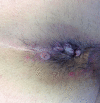Syphilis in Dermatology: Recognition and Management
- PMID: 36689103
- PMCID: PMC9869822
- DOI: 10.1007/s40257-022-00755-3
Syphilis in Dermatology: Recognition and Management
Abstract
The incidence of syphilis has been increasing in the USA since 2000. Notably, the coronavirus disease 2019 pandemic negatively impacted the public health efforts to contain the spread of sexually transmitted diseases including syphilis and congenital syphilis. Clinical manifestations of syphilis are predominantly mucocutaneous lesions, thus dermatologists are primed to recognize the myriad presentations of this disease. Primary syphilis is classically characterized by a painless transient chancre most often located in the genital area. Secondary syphilis typically manifests clinically as systemic symptoms in addition to a mucocutaneous eruption of which a variety of forms exist. Although less common in the era of effective penicillin treatment, late clinical manifestations of syphilis are described as well. In addition to recognition of syphilis on physical examination, several diagnostic tools may be used to confirm infection. Treponema pallidum spirochetes may be detected directly using histopathologic staining, darkfield microscopy, direct fluorescent antibody, and polymerase chain reaction assays. A table detailing the histopathologic features of syphilis is included in this article. Serologic testing, non-treponemal and treponemal tests, is the preferred method for screening and diagnosing syphilis infections. Two serologic testing algorithms exist to aid clinicians in diagnosing positive syphilis infection. Determining the correct stage of syphilis infection combines results of serologic tests, patient history, and physical examination findings. Using the current Centers for Disease Control and Prevention case definitions and treatment guidelines, a management algorithm is proposed here. Penicillin remains the pharmacological treatment of choice although specific clinical situations allow for alternative therapies. Syphilis is a reportable disease in every state and should be reported by stage according to individual state requirements. Screening recommendations are largely based upon risks encountered through sexual exposures. Likewise, sexual partner management includes evaluating and treating persons exposed to someone diagnosed with an infective stage of syphilis. Close clinical follow-up and repeat testing are recommended to ensure appropriate response to treatment. This guide will discuss the current epidemiology of syphilis and focus on practice aspects of diagnosis and management, including public health reporting.
© 2023. This is a U.S. Government work and not under copyright protection in the US; foreign copyright protection may apply.
Conflict of interest statement
There are no financial disclosures, commercial associations, or any other conditions posing a conflict of interest to report for any of the authors.
Figures





Similar articles
-
Sexually acquired syphilis: Laboratory diagnosis, management, and prevention.J Am Acad Dermatol. 2020 Jan;82(1):17-28. doi: 10.1016/j.jaad.2019.02.074. Epub 2019 Apr 12. J Am Acad Dermatol. 2020. PMID: 30986474 Review.
-
Syphilis and HIV co-infection. Epidemiology, treatment and molecular typing of Treponema pallidum.Dan Med J. 2015 Dec;62(12):B5176. Dan Med J. 2015. PMID: 26621404
-
[Recent Advances in Laboratory Diagnosis of Syphilis].Mikrobiyol Bul. 2023 Jan;57(1):141-155. doi: 10.5578/mb.20239912. Mikrobiyol Bul. 2023. PMID: 36636853 Review. Turkish.
-
Update on syphilis and pregnancy.Birth Defects Res. 2017 Mar 15;109(5):347-352. doi: 10.1002/bdra.23562. Birth Defects Res. 2017. PMID: 28398683 Review.
-
Treponema pallidum PCR testing for diagnosis of mucocutaneous ulcers suspicious for syphilis.Sex Transm Infect. 2022 Aug;98(5):380-382. doi: 10.1136/sextrans-2021-055192. Epub 2021 Nov 16. Sex Transm Infect. 2022. PMID: 34785619 Review.
Cited by
-
Unilateral Photopsia: An Unusual Case of Syphilitic Endophthalmitis.Cureus. 2025 May 12;17(5):e83984. doi: 10.7759/cureus.83984. eCollection 2025 May. Cureus. 2025. PMID: 40510062 Free PMC article.
-
A Peculiar Pattern: Nodular Secondary Syphilis with Granulomatous Dermatitis.Acta Med Philipp. 2024 Sep 30;58(17):60-63. doi: 10.47895/amp.v58i17.9040. eCollection 2024. Acta Med Philipp. 2024. PMID: 39431263 Free PMC article.
-
The Rise of Syphilis Infections and Reinfections over a Decade (2009-2019) in the Bolognese Area: A Retrospective Analysis.Microorganisms. 2025 Jan 27;13(2):285. doi: 10.3390/microorganisms13020285. Microorganisms. 2025. PMID: 40005652 Free PMC article.
-
Tertiary Syphilis-Induced Ocular Syphilis Complicated by Retinal Detachment.Cureus. 2025 Mar 26;17(3):e81240. doi: 10.7759/cureus.81240. eCollection 2025 Mar. Cureus. 2025. PMID: 40291298 Free PMC article.
-
Alopecia as the initial presentation of secondary syphilis: A case report and review of literature.IDCases. 2025 Jul 9;41:e02314. doi: 10.1016/j.idcr.2025.e02314. eCollection 2025. IDCases. 2025. PMID: 40688427 Free PMC article.
References
-
- Centers for Disease Control and Prevention. Sexually transmitted disease surveillance 2020. Atlanta (GA): U.S. Department of Health and Human Services; 2021.
-
- Centers for Disease Control and Prevention. Sexually transmitted disease surveillance: preliminary 2021 data. Atlanta (GA): U.S. Department of Health and Human Services; 2022.
MeSH terms
Substances
LinkOut - more resources
Full Text Sources
Medical

